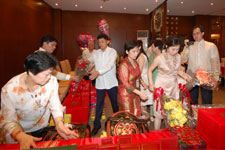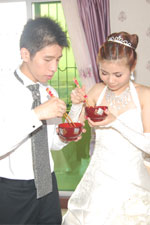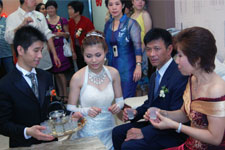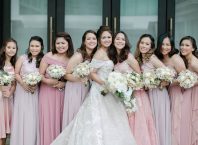
By Jonathan Dionisio | July 2009
Even before the Spaniards re-discovered the Philippines, our ancestors have been trading with the Chinese for a long period of time, tracing back to the Ming Dynasty. These foreigners came to the Philippines to migrate and seek better opportunity in life. Through constant trade relations, a partnership between Filipinos and Chinese flourished, which brought about interracial marriages. And with that came Filipino-Chinese, or who we know now as Tsinoy.
The Chinese, like the Filipinos, have unique wedding traditions, ceremonies, and even superstitions. Because China is a large country, each clan has its own special tradition and customs. Their traditions mixed with the Filipinos, made Filipino-Chinese weddings even more colorful. Here is a guide on the basic wedding rituals of the Filipino-Chinese.
Identifying the Wedding Date
Once the future bride has accepted the marriage proposal of the future groom, the couple consults a Feng Shui expert to assist them in choosing the date of their Kiu Tsin or Kiu Hun or pamamanhikan (asking of hand in marriage), Ting Hun or engagement, and Kan Chiu or wedding ceremony. The Feng Shui expert determines the most auspicious date and time for these three important occasions based on the Chinese Zodiac sign of the marrying couple, their parents, and grandparents.
Kiu Hun or Kiu Tsin – Pamamanhikan (Asking of Hand in Marriage)
The future groom and his family visit the future bride and her parents to formally ask for her hand in marriage. The groom’s family brings basket of fruits and sweets to the bride’s family. These gifts represent fertility and prosperity in Chinese culture. During this time, both families discuss about the wedding date, wedding preparation, and other details.
Once the dates have been identified, both families prepare their traditional gifts for each other. For the Formal Engagement, the bride and her family have to prepare the following gifts; each one should have Sang Hee or double happiness sticker on top. Sang Hee stands for Marital Happiness.
A. Jewelry
– Men’s watch
– Men’s necklace with medallion pendant
– Men’s bracelet/ring (optional)
B. Cake (should be round or heart shape)
– Bigger size of cake with groom’s name (in Chinese characters)
– Smaller size of cake with bride’s name (in Chinese characters)
C. Others:
– 4 pieces Pomelo
– 2 kilos of uncooked rice
– 120 pieces of raw egg
– 3 kinds of Chinese hopia (special bean-filled pastry) set
– Assorted candies and/or cookies
– Red table cloth (bridal satin) to be used to cover display table
– Suit/barong material for the groom
Below are the gifts the groom and his family have to prepare, with Sang Hee sticker on top:
A. Jewelry
– Wedding rings
– Lady’s watch
– Lady’s necklace with medallion pendant
– A pair of Chinese bangles with red thread
– Sets of jewelries placed in a red box
B. Ang Paos
– 2 pairs of Ang Paos, one pair of small amount and one pair of big amount
C. Fabric (Quantity of clothes/fabric should be in even numbers)
D. Flowers
– One box of corsage
– One box of boutonnière
– Six (6) or eight (8) varieties of flowers (all colors are allowed except white)
E. Fruits
– Boxes of fruits (in even numbers)
– 4 pieces of Pomelo
F. Canned Goods
– Canned porklegs (in even numbers)
– Canned fruit cocktails (in even numbers)
G. Chinese Hopia
– Each set has four (4) kinds of Chinese delicacies. (minimum of 12 sets)
H. Candies and cookies (preferably chocolate coins)
I. Chinese misua (placed in red boxes)
J. Gifts
– for the bride’s parents and senior members of the family (usually a suit/barong fabric for men and lace fabric for women)
– Sin Na (a 4-layered basket made out of bamboo)
After preparing the gifts, the participants of the formal engagement party are chosen based on the compatibility of their Chinese zodiac signs to the marrying couple and both parents. This is to avoid the presence of bad luck or negative energy during the ceremony.
Family members and guests who are incompatible are not allowed to witness the ceremony but they are welcome to join the reception. Engaged couples and pregnant women are not allowed as well because the Chinese believe that they may pull out the luck intended for the marrying couple.
Ting Hun – Formal Engagement Ceremony
On the day of the Formal Engagement Ceremony, called Ting Hun, no formal invitations will be printed or distributed for this occasion. However, the groom parents shall have it announced in a local Chinese newspaper ad on the day itself.
During the Ting Hun, the groom’s engagement party arrives at the ceremonial place an hour before the said time. The ceremony begins with the bride’s parents welcoming and receiving the groom’s party. First, the groom enters with the box of corsage in his hand. He is followed by his relatives who will enter the ceremony venue in two’s, with each pair carrying a Sin Na. They are followed by the parents of the groom, and last, the other representatives of the family carrying the other gifts.
As the gifts are being carried into the ceremonial room, the elder representatives of the groom fix the ceremonial table, cover it with the red bridal satin cloth and place the gifts on top.
After the groom’s family has entered, their chosen representatives are asked to proceed to their ceremonial seats together with the bride’s chosen representatives.

The bride enters the ceremonial room walking backward. This is to avoid negative energy and to avoid her from seeing the groom.
The bride is turned three times clockwise by her escort. After which, he allowed to look at the groom. Welcome drink such as red or orange juice, which denotes good luck and happiness, is served as soon as the bride is seated. The bride’s female family member serves the drink to both entourages, from eldest to youngest, before it is served to the marrying couple.
Once the marrying couple is served, the families can now proceed to exchanging of gifts or Gift-Giving Ceremony.
After the exchange of gifts, the Wedding Tea Ceremony comes next. For Chinese, tea plays a significant part on both engagement and wedding as tea symbolizes respect. During the tea ceremony, the bride serves the tea to the groom’s family in order of seniority. She is followed by the groom who, in turn, serves the bride’s family in the same order. Through this ceremony, the bride is formally introduced to the family of the groom.
Once all the guests have been served with tea, formal pictorial follows. It may be followed in this sequence:
1. Newly engaged couple
2. Couple with bride’s parents
3. Couple with bride’s immediate family
4. Couple with both parents
5. Couple with groom’s parents
6. Couple with groom’s immediate family
7. Couple with groom’s engagement party
8. Couple with bride’s engagement party
9. Couple with bride’s relative
10. Couple with bride’s friends

The family members of the bride prepare the dining table where the engagement party will take sweet tea soup and misua, a symbol of long lasting relationship.
The bride’s mother invites the engagement party for sweet tea soup and misua eating as part of the ceremony. Each guest at the table is served with a bowl of sweet tea soup, containing two pieces of eggs, two pieces of red dates and two pieces of sliced condoles. The sweet taste of the tea soup is a wish for sweet relations among the bride and her new family. One doesn’t need to finish two eggs. If unable to finish, he/she may cut the remaining egg in half. However, should anyone choose not to eat them, he/she may opt to leave them in pair. Pair signifies a couple’s togetherness.
After the sweet tea soup, bowls of misua are served. The same procedure in serving is followed, with the elders served first and the marrying couple served last.
After the misua is eaten, the Ang Paos are returned to the groom, who in turn, returns the money to his parents. The bride’s female family members distribute flowers to the single ladies while other female members prepare goodie bags for giveaway.

The groom places back the cakes displayed earlier at the table in their respective boxes. He carries the cake with bride’s name, while the cake bearing his name is carried by one of his representative. Riding a car, they will drive around the block of the ceremonial venue twice. Driving around is like forming a circle, a shape which signifies unending union or lasting relationship of the couple. The groom comes back carrying the cake with his name and leaves the other cake in his car. The numbers of Sin Na’s content and other goodies is divided into half and are returned to the groom’s family before or after the reception.
After this ceremony, the bride and groom, together with their family and those who were not allowed to witness the ceremony, eat at the prepared reception.
Pre-Wedding Customs
After the Ting Hun, the couple arranges a visit to chosen individuals to formally ask them to serve as principal sponsors. The couple brings a basket of goods containing canned pork leg, misua, canned fruit cocktail and sweets during their visit. Once the prospect sponsors agree, the couple visits again to bring fabric for his or her attire for the wedding.
Other couples may only pay one visit to their future sponsor who is really close to them. They bring along the fabric together with the basket of goods on the day of their visit.
Both bride and groom have their own pre-wedding preparations. For the groom, he delivers the bridal gown and other accessories at the bride’s house. He gives this to the sister or mother of the bride. This is because the Chinese, like Filipinos, believe that the couple must not see each other before the wedding day.
Another task for the groom is to install the matrimonial bed at the couple’s new room. This is a new bed complete with cases, comforters, pillows, and sheets sprinkled with red dates, oranges, lotus seeds, peanuts, pomegranates and other fruits. The installation date is chosen by a Feng Shui expert. Once the bed has been installed, a baby boy born under the Year of the Dragon is made to roll around and sleep on the bed to ensure the couple’s future in bearing a son. Some families require the groom to sleep on the bed as well. For other Tsinoys, a respected relative considered as a ‘good luck man’ or ‘good luck woman’, a man or woman with many children and living mates, will install the bed. They are the ones asked to play on the bed to pass their good luck and fertility to the soon-to-wed couple.
For the bride, she prepares her personal belongings, called Ke Tseng to be brought to her new home. These are neatly wrapped and are all labeled with Sang Hee. The bride’s dowry is mainly interior ornaments or daily necessities. Wealthy parents have the options of giving complete home appliances, car, and real estate property. Ke Tseng items include:
– A pair of red lantern
– A mirror covered in red cloth to dispel bad energy
– A pair of floral arrangement in a vase
– A pair of Mini Sin Na filled with sweet and Chinese herbs
– Small urinal/toilet kettle
– New sets of clothing
– New sets of jewelry
– New sets of suit case
– A baby bath tub with toiletries
These items are then brought to the new house on a given date and time by the Feng Shui expert. The bride’s siblings bring all the items to the new house. Once everything has been brought to the new house, the family of the bride is served with misua, hard boiled egg and drinks. They will also receive Ang Paos as a token of gratitude.
Kan Chiu – The Wedding
On the day of the wedding, more traditions are followed. For the wedding itself, formal invitations are printed and distributed to relatives and friends. The groom’s parents will again announce the wedding in a local Chinese newspaper.
During the preparation of the bride, she wears a red robe with a dragon emblem while having her hair and make up done. After changing into her bridal outfit, her father is tasked to comb her hair 2 to 4 strokes downward to remove bad luck. A pair of Sang Hee coin is sewn in her entire outfit: bridal gown, long veil, stockings and shoes. Same thing goes with her future mother in law’s stockings and shoes that were given by the bride.
When the bride is prepared to leave for the church, she throws a fan bearing Sang Hee sign to family member sending her off. The bride’s mother would pick it up and keep it. This gesture shows that her leaving will not take away all the good fortune from her family.
The wedding ceremony depends on the religion of the couple. Based on study, most Tsinoys are Catholics, thus following the Catholic wedding ceremony. Some practice their traditional Chinese religion, such as Mahayana Buddhism and Taoism, side by side with Catholicism or other religions.
Another tea ceremony takes place after the wedding ceremony and before they head to the reception. This is held in their new home or a small room at the reception venue. It is done by the newlywed couple and the groom’s family. The bride serves tea to the groom’s family in order of seniority which is similar to their engagement. After the drinking of tea, she receives a gift or Ang Pao from each member of the groom’s family. Gifts are usually in form of red envelopes or Ang Pao and contain money or jewelry. Some relatives prefer that the bride uses the jewelry immediately. After which, the bride gives her gift to the elders of the family. Misua is served to the couple after.
The Wedding Reception
Common must-have food for Chinese wedding banquet consists of fish, roast suckling pig, pigeon, chicken cooked in red oil, lobster and desert bun with lotus seeds stuffed inside. Each of these dishes represents a significant wish for the young couple. But nowadays, Tsinoys are more open to serving other cuisines. During the reception, members of the entourage are given Ang Paos by the groom’s family. At times, the bride’s family gives Ang Paos to the entourage members as well.
Post Wedding Rituals
After the wedding reception, the couple proceeds to their new home and removes the red satin cloth covering the mirror. Then, two single brothers or male relatives of the bride gives the couple Wa Hue set. This is a bouquet of flowers with umbrella and sewing kit. The bride receives the gifts and gives Ang Pao in return.
Three days after the wedding, the couple visits the house of the bride’s parents. The day of the wedding is counted as day one, so if the wedding falls on a Sunday, Tuesday will be the third day. The couple will have lunch with the bride’s parents. After the meal, the couple is sent home with a pair of sugar cane branch or a bottle of sugar cane juice and a live rooster and hen placed in a cage. The sugar cane represents sweet and harmonious life.
Once the couple gets back home from their visit, they proceed to their bedroom and release the chickens. It is believed that if the rooster comes out first, the first born will be a boy; if it is the hen, then their first born will be a girl.
The Filipino-Chinese wedding is very colorful and detail-oriented. Although this may seem tiring or extravagant, families do this in honor of their tradition which has been passed from generation to generation. After all of these rituals, the newlywed couple, just like other couples, begins their lifelong commitment of fidelity, trust, and love for one another.
. . . . . . . . . . . . . . . . . . . . . . . . . . . . . . . . . . . . . . . . . . . . . . . . . . . . . . . . . . . . . . . . . . . . . . . . . . . . . . . . . . . . . . .
Kasal.com would like to thank:
Ms. Zyndee Co, Special Events Consultant for sharing her knowledge and expertise on Filipino-Chinese weddings.
Ms. Zyndee Co is currently the in-house wedding coordinator of Mr. Edward Teng, Crystallize Souvenir Shop, B.A. Studio and Lasting Impression Gift Shop.
Other Sources:
Chinese Historical and Cultural Project. Chinese Wedding Traditions
http://www.chcp.org/wedding.html#preparations
983Weddngs.com. Chinese Wedding Traditions – Marriage Customs
http://www.983wedding.com/chinese/
China Bridal. Chinese Wedding Customs & Rituals
http://www.chinabridal.com/etiquette.htm
Parker, Natalie Juliette, Tsinoy.com. Chinese Wedding Tea Ceremony.
http://www.Tsinoy.com/article_item.php?articleid=591
Fact Archive.com. Chinese Filipino: Religion
http://www.fact-archive.com/encyclopedia/Chinese_Filipino




